Key takeaways
- Foucault’s archaeology shifts focus from events to the underlying structures that shape knowledge and discourse, encouraging critical questioning of accepted norms.
- The concepts of episteme and discourse reveal why some ideas prevail while others disappear, emphasizing historical discontinuity over linear progression.
- Teaching archaeology fosters a mindset of skepticism and inquiry, equipping students to analyze the hidden rules governing knowledge across different eras.
- Applying archaeology to learning transforms student engagement, making knowledge exploration a dynamic process rather than simple memorization.
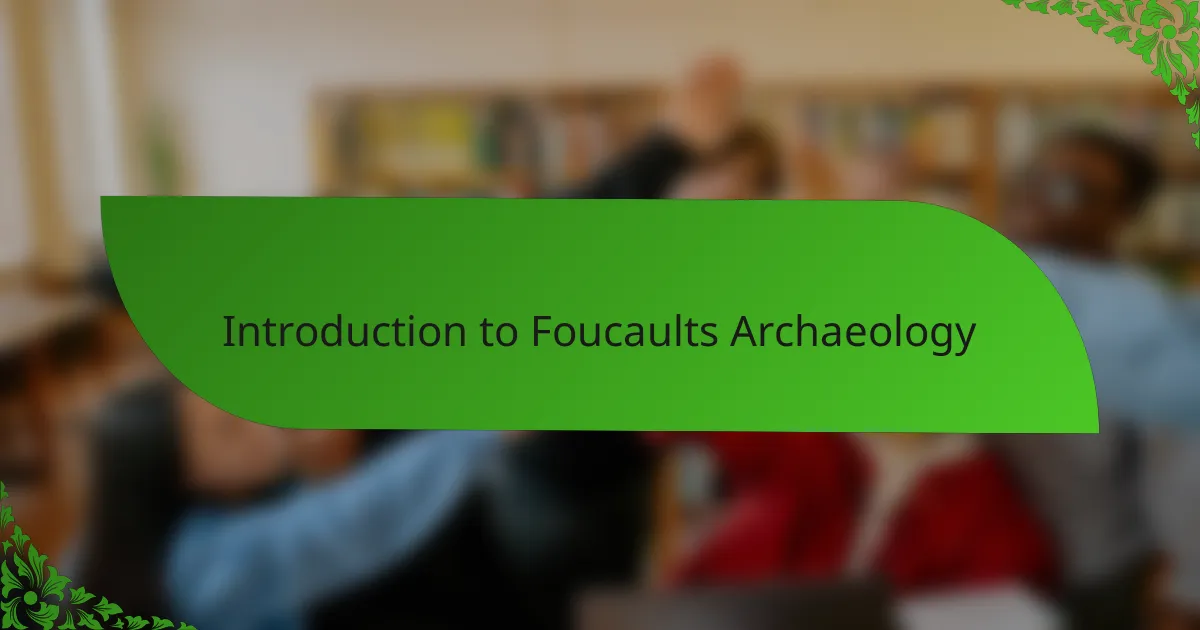
Introduction to Foucaults Archaeology
When I first encountered Foucault’s concept of archaeology, I was struck by how it challenges traditional history. Instead of focusing on events or individuals, archaeology digs into the underlying rules and structures that shape knowledge itself. Have you ever wondered how certain ideas just seem “normal” or “natural” over time?
What fascinates me most is how archaeology reveals the invisible frameworks—those unspoken conditions that determine what can be said or thought in any era. It’s like peeling back layers to uncover the foundations of our understanding, often hidden beneath what we take for granted. This approach made me rethink how knowledge is not just discovered but constructed.
In my experience teaching philosophy, introducing students to Foucault’s archaeology always sparks curiosity. It opens a pathway to question how disciplines, discourses, or even social practices come into being. It’s as if archaeology invites us to become detectives of thought, searching for the “rules of the game” behind our beliefs.

Key Concepts in Archaeology Philosophy
What really stands out to me in Foucault’s archaeology are the concepts of episteme and discourse. These aren’t just fancy words—they represent the deep structures that define what counts as knowledge in a given period. I remember feeling a bit overwhelmed at first, but then I realized how powerful this lens is for understanding why some ideas gain traction while others just fade away.
Another key idea is that archaeology focuses on discontinuities rather than continuous progress. This perspective challenged my own assumptions about history as a smooth evolution of ideas. Instead, I began to see history as a patchwork of different rules and practices, where what seems obvious now would have been unimaginable a century ago. Have you ever felt like you’re living in an entirely different reality just by shifting your viewpoint?
Lastly, I find the archaeological method itself intriguing—it’s not about uncovering facts but about analyzing systems of thought. This approach requires patience and a willingness to look beyond surface appearances. When I guide students through this process, I notice their excitement grows as they start connecting the dots between seemingly unrelated ideas and realize how deeply culture shapes knowledge.
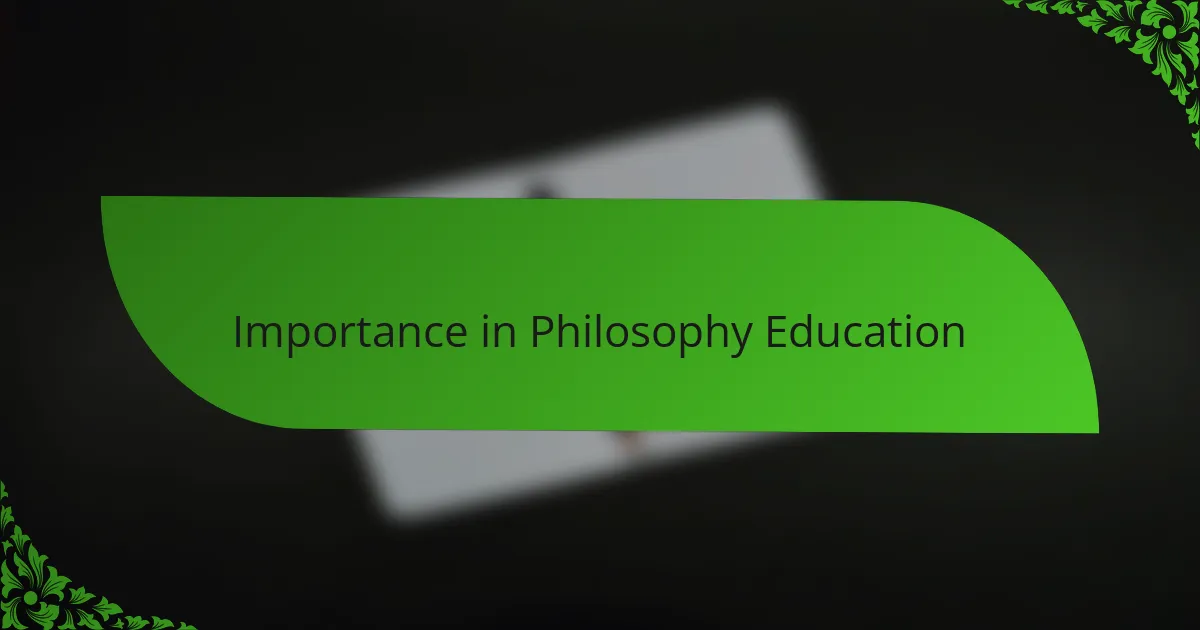
Importance in Philosophy Education
When I first brought Foucault’s archaeology into my philosophy classes, I noticed how it transformed students’ approach to learning. Instead of passively absorbing facts, they began actively questioning the “why” behind knowledge itself. Have you ever experienced that moment when a concept suddenly clicks, and everything you knew feels a bit more uncertain? That’s the kind of critical thinking Foucault encourages, and I believe it’s essential for philosophy education.
What I appreciate most is how archaeology equips students to uncover the hidden “rules” that govern thought in different eras. This goes beyond memorizing theories; it cultivates a mindset of skepticism and inquiry. In my teaching, this helps learners develop a deeper awareness of how power and culture shape what we accept as truth—which feels increasingly relevant in today’s complex world.
Philosophy education isn’t just about ideas floating in isolation. Archaeology reminds me that knowledge is part of a larger system, and understanding these systems helps students see philosophy as a living, dynamic discipline. When students recognize that their own perspective is shaped by historical conditions, it fosters humility and curiosity. Isn’t that what philosophy is really about?
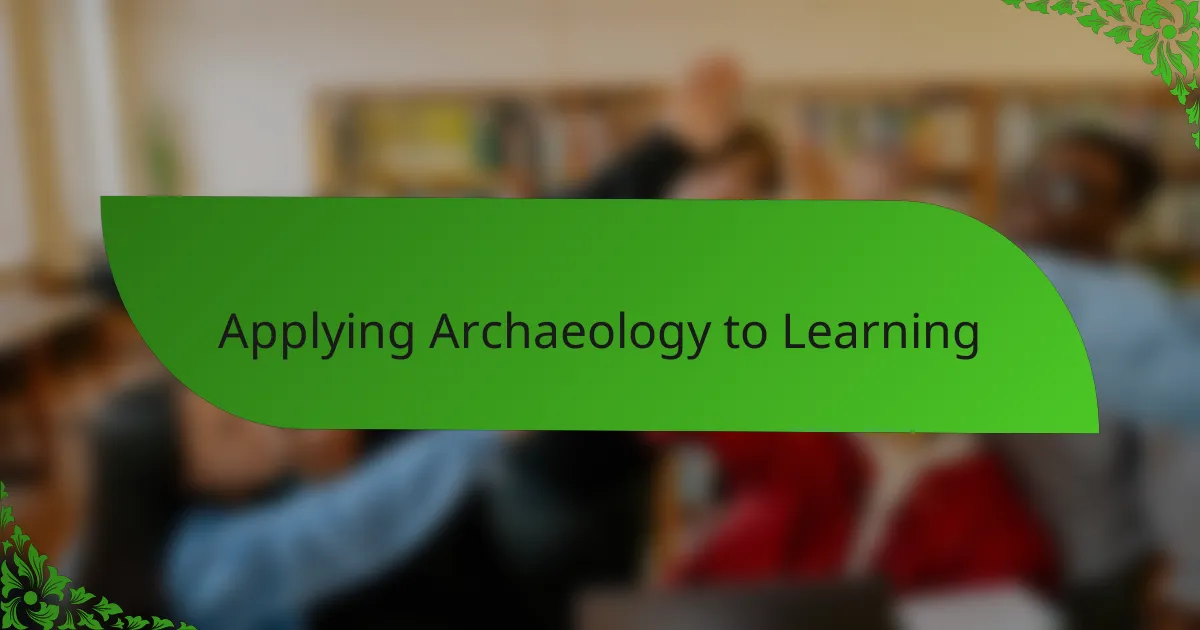
Applying Archaeology to Learning
Applying archaeology to learning, I’ve found, changes the way we engage with knowledge itself. When students uncover the underlying structures that shape what we consider “true,” they stop seeing learning as mere memorization and start seeing it as exploration. Have you ever noticed how peeling back these layers can make even familiar subjects feel newly alive?
In practice, this means encouraging learners to ask: Why is this knowledge accepted now? What rules governed its emergence? I remember guiding a class through a text, and the moment they began to question the assumptions behind the author’s claims, their curiosity soared. It’s like giving them a map to navigate the hidden terrain beneath the surface of ideas.
Applying archaeology also softens the sense that knowledge is fixed or final. Instead, it reveals how what we learn is always tied to specific historical conditions—sometimes arbitrary, sometimes surprising. When students realize that today’s truths were once unimaginable, it opens up a space for creativity and critical thinking that I find deeply rewarding to witness.
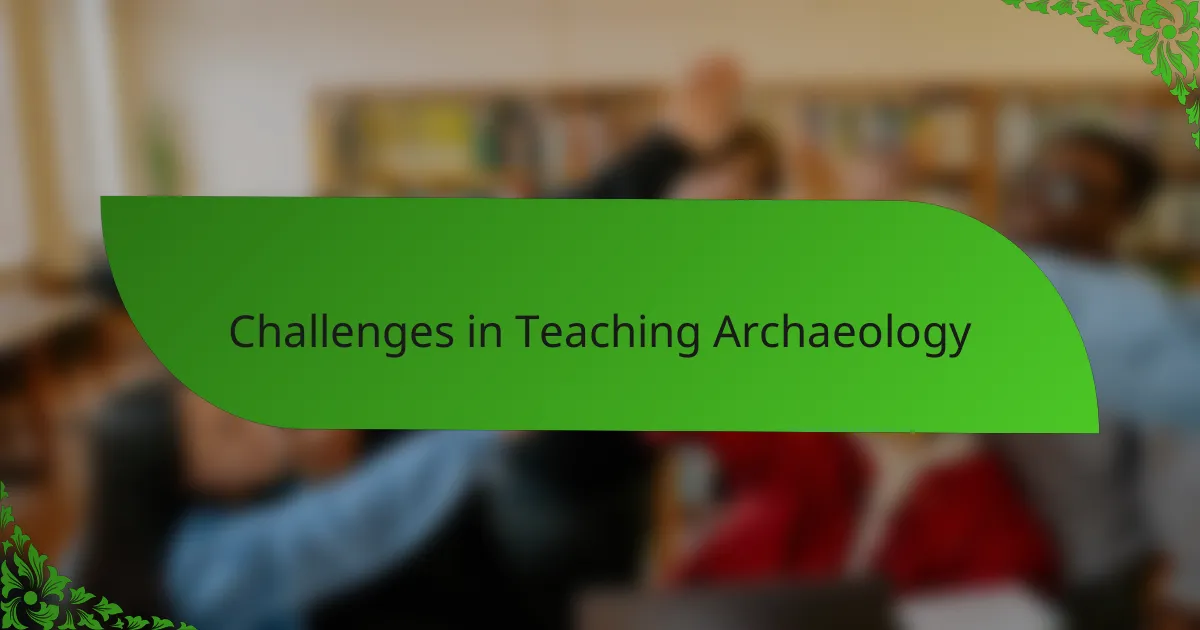
Challenges in Teaching Archaeology
Teaching Foucault’s archaeology is not without its hurdles. I’ve noticed that students often struggle with the abstract nature of concepts like episteme and discourse—it’s one thing to grasp history as stories, but quite another to analyze invisible rules shaping knowledge. Have you ever tried explaining something so subtle that it feels like chasing shadows? That’s how it can feel at first.
Another challenge lies in guiding students to appreciate discontinuity instead of a smooth progression of ideas. I remember one class where learners kept insisting history must be linear and coherent. Shifting that mindset requires patience and creative examples—sometimes I compare it to watching fragmented scenes of a movie and asking them to piece together the plot. This exercise isn’t easy, but when it clicks, it’s rewarding to see their eyes light up with new understanding.
Finally, the archaeological method demands a kind of intellectual patience that many find uncomfortable. It’s not about collecting facts but about critically examining systems of thought nested within cultural contexts. I often remind my students that this is like being detectives of knowledge—sometimes we must accept uncertainty and ambiguity before the full picture emerges. Encouraging that open-mindedness can be a delicate balance, but the breakthroughs make it worthwhile.
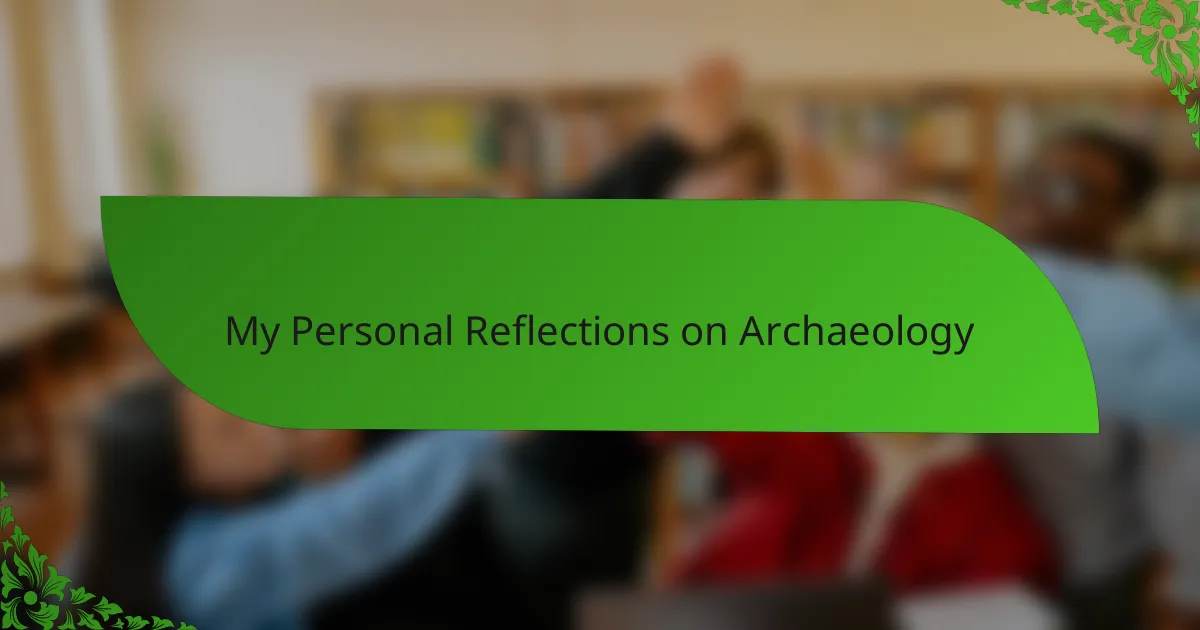
My Personal Reflections on Archaeology
Reflecting on archaeology, I often find myself fascinated by how it disrupts my usual ways of thinking. When I first tried to apply its method outside the classroom, I realized how tricky it is to resist the urge to see knowledge as straightforward or cumulative. Have you ever caught yourself assuming that what you know is simply “true,” only to have archaeology quietly challenge that belief?
There was a moment during one of my own studies when I uncovered a set of ideas that felt completely alien at first—so distant from my current worldview that I had to pause and reconsider what I thought was obvious. It was a humbling experience. I felt like I was peeling back layers of an onion, revealing not facts but rules and assumptions I hadn’t even noticed before.
What I appreciate most personally is that archaeology teaches patience and curiosity in equal measure. It’s a reminder that understanding the landscape of knowledge isn’t about quick answers but about embracing complexity. Hasn’t it always felt more rewarding when you’ve unraveled something slowly, step by step, rather than being handed ready-made conclusions? That’s exactly the kind of intellectual journey archaeology invites us to take.
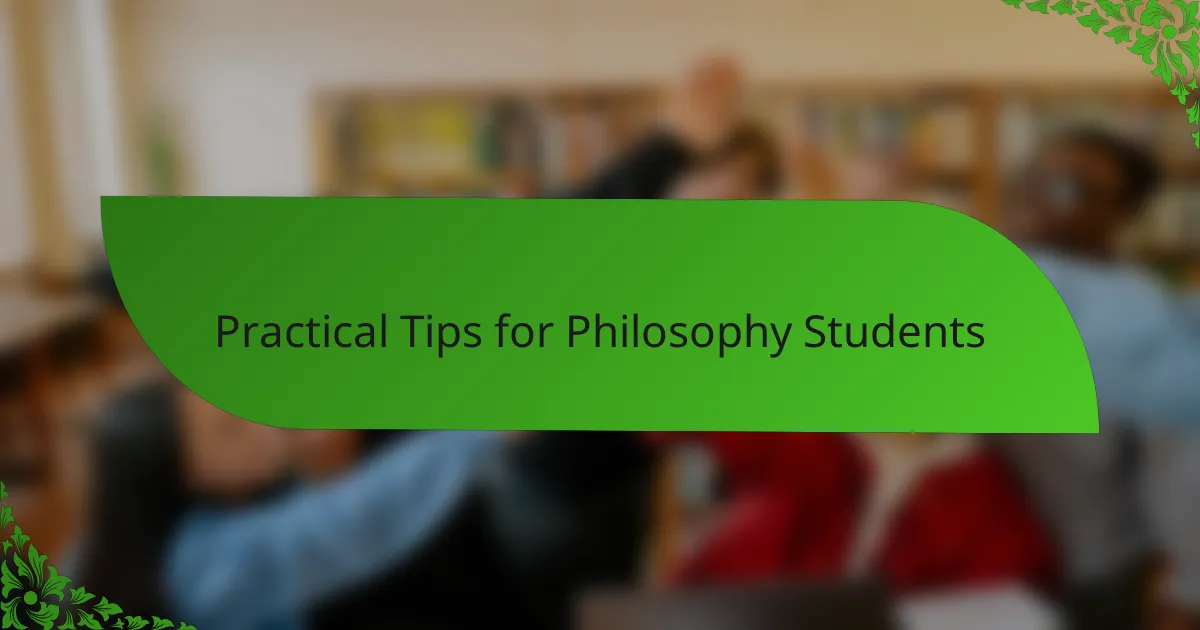
Practical Tips for Philosophy Students
One thing I often tell philosophy students is to embrace patience when tackling Foucault’s archaeology. The concepts aren’t always immediately clear, and it takes time to see how these hidden structures operate beneath familiar ideas. Have you noticed how stepping back and letting thoughts simmer can open up new insights? That pause makes all the difference.
Another practical tip is to keep asking “Why?”—why is this knowledge accepted, and what conditions made it possible? When I started doing this myself, I realized it transforms reading from a passive activity into an active investigation. It’s like being a detective, piecing together clues that reveal how our understanding is shaped.
Finally, I encourage students to discuss their interpretations openly, even if they feel uncertain. Philosophy, especially when dealing with archaeology, thrives on shared exploration and questioning. Have you ever found that explaining your thoughts aloud uncovers new angles you hadn’t considered? That kind of dialogue often deepens both comprehension and curiosity.